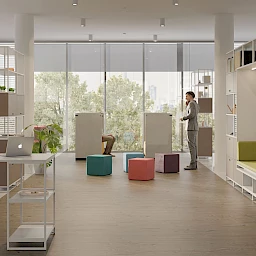The current Statista trend report on changes in the world of work clearly shows that new forms of work have received a real boost in recent years. This is coupled with a change in employees’ valuation of work. Generation Z in particular is regarded as a driver of new developments. What exactly do employees want from companies and what does this mean for the work models of tomorrow?
Gen Z is a driving force behind new concepts of working time arrangements
Generation Z is regarded as well-qualified and prepared for change. When they’re looking for a new employer, people born between 1995 and 2010 assume they will have a flexible working time arrangement. The option of working from home or in places other than the office is more important for Gen Z than for any other generation. Most of its members expect to be permitted to take sabbaticals or workations. Jenny Maertens, an expert for transformation, innovation and New Work, adds that young employees also consider it important to have codetermination and a sense of purpose, and to receive appreciation of their individuality and their work. She says that Gen Z members set great store by opportunities to make a personal contribution and put their values into practice.
We need a new definition of the role played by managers!
In the future, managers will become even more important in relation to fostering employees’ loyalty and satisfaction. That’s why their role must be redefined in order to meet employees’ demands regarding their work and their work environment. In the past, professional skills were the key factor for filling a vacancy, but in the future social skills will be in demand more than ever before, so that managers can lead cross-generational teams, manage diversity, and promote employees’ personal development. This requires coaches who actively give feedback from the sidelines and develop reskilling and upskilling processes based on individuals’ profiles of talents and preferences. In addition, managers will have to know how, where and when they should integrate the “new colleague AI” into the immediate work environment in order to provide relief from routines and repetitive tasks in daily work, thus gaining more free time for personally significant learning and creativity. If this improves employees’ work-life integration, all the better.
The transformation of the world of work is accompanied by new office concepts
According to a representative forsa survey of 1,003 employees that was conducted by the German Interior Business Association, today 47 % of employees can freely decide for themselves how much of their working time they will spend at the office. A total of 82 % of the survey respondents said that personal contact with colleagues and managers was one of the reasons for working at the office. And 68 % of them said that the opportunity to talk with colleagues and managers about work-related matters was another reason for coming to the office. Participation in workshops and teamwork was yet another reason for working at the office, according to at least 32 % of the respondents. Suitable spatial concepts for more workshops and teamwork are required. However, companies still lack areas for spontaneous meetings and casual conversations, as well as the opportunities for learning from and with one another that these encounters offer.
What needs to be done?
- Developing the office into a place of identification and inspiration
- Paying attention to hospitality and a welcoming atmosphere early on in the spatial planning stage; the key term is “corporate hospitality”
- Including employees in spatial planning activities, while simultaneously supporting the planning process with experts. Craig Knight, a psychologist and an expert for effective workplace design, calls this the “empowered workplace”
- Transformation of the office into a creative learning environment
The Statista trend report identifies the following spatial elements as necessary for adapting the office environment to New Work requirements: collaboration areas (closed spaces for creative work and workshops, as well as open spaces for collaboration), retreat spaces, social areas or common areas for breaks and informal meetings, individual workstations in the form of quiet areas for silent work and working areas for teamwork. Of course the list also includes traditional conference rooms that are equipped with technology for hybrid meetings as well.
The boundary between desirable and feasible elements
In the area of working time arrangements, many companies have already reacted to the transformation and the changed expectations of their employees. Spatial design will also be adapted to the new requirements. All of this is appropriate and important. Nonetheless, in all the discussions of workations, sabbaticals, work-life integration and the four‑day week, we should keep in mind that every coin has two sides. Yes, we have an employee market and companies must do more to gain employees’ loyalty and retain them within the company. These efforts can succeed through corporate culture, good managers, appropriate salaries and supportive spatial design. But companies cannot be held responsible for every area of life. The office offers a base, but it can’t replace an employee’s home. It’s a place where you can meet your colleagues, but it doesn’t replace your family and friends. It offers ergonomic workstations, but it doesn’t replace individuals’ responsibility to maintain their own physical and mental health. In the future, the negotiation processes between everyone involved — employers and employees — and the way these processes are moderated will show where to draw the boundary between desirable and feasible elements.




 Jasmin Najiyya
Jasmin Najiyya 


